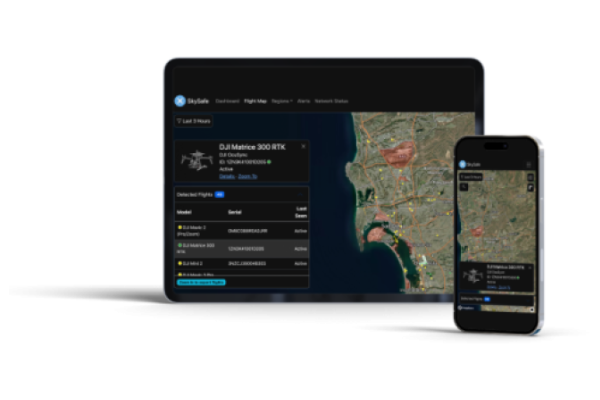When lives are on the line, you need reliable, secure, unbroken communications. From the most extreme moments to the day-to-day, emergency personnel depend on mission critical communications to do their jobs effectively and keep our communities safe – it is their lifeline.
Today, mission critical communication plays a vital role in enabling emergency personnel to stay connected and protect communities around the world. Public safety organizations and agencies – including national, local, state and regional police, fire, and emergency medical services – have long turned to narrowband, two-way radio for their mission critical communication needs. These land mobile radio (LMR) networks have long served to deliver proven, reliable voice communication in life-and-death situations.
However, public safety needs are evolving – and that evolution requires new forms of communication. The past fifteen years have seen advances in mobile broadband technology drive the growing demand for real time data. Within public safety, agencies are leveraging this advanced mobile intelligence to access video, pictures and location data to resolve incidents and make informed decisions in real time. As organizations continue to incorporate data into their workflow and mobile broadband plays a larger role in the mission critical communications mix, agencies may find themselves struggling to navigate the complex and ever-evolving mission critical public safety communications landscape.
More than 20 years ago, Motorola Solutions recognized the need for an efficient, easy-to-understand benchmark for evaluating technology choices. In response, we introduced the five Cs of critical communication – coverage, capacity, cost, control and capability. Today’s environment requires you to consider a sixth C – cybersecurity.
Together, these six Cs play an important role in effectively assessing mission critical communications. You want to make sure you make the best decisions for the people on the front lines. With a multitude of information discussing the pros and cons of both LMR and mobile broadband, making the right choice can seem like a daunting task.
But maybe it doesn’t have to be! In fact, many industry leaders argue that the right solution for public safety is to leverage both options in order to achieve mission critical communication success. Today, and in the near future, there is no one system that can successfully provide both mission critical voice and broadband data communications. As public safety agencies around the world explore different ways to address their needs for reliable communications, the solution is to leverage both LMR and mobile broadband. These serve as complementary technologies – with LMR providing essential mission critical voice communications and mobile broadband providing additional data-driven capabilities. Together, they provide a collaborative solution that is able to respond effectively and efficiently to today’s public safety communication needs.
By bridging these two technologies and connecting LMR and mobile broadband networks together, public safety agencies are creating forward-thinking, collaborative networks that address all of the six Cs of mission critical communications – coverage, capacity, cost, control, capabilities and cybersecurity.
- Capacity: Are your communications systems capable of supporting everything and everyone they need to during times of crisis? Will calls be prioritized so the most important information gets through first? A successful mission critical communication system seamlessly handles mass call volumes, prioritizes important calls and ensures necessary agencies are able to access the network. It must be engineered to address peak usage and right-sized to your organization’s specific needs to ensure calls always get through – regardless of the circumstances. Current LMR networks are designed for emergencies with capacity calibrated for maximum usage. By including mobile broadband, your agency is able to extend your user base and ensure that all critical individuals are able to access the communications network.
- Coverage: Does your system meet your unique geographical and performance requirements? No one can predict where the next incident will occur. You need a robust communication system with superior coverage across your entire jurisdiction and sufficient back-up and redundancies to prevent communication gaps and losses. Infrastructure should be easily supported and serviced to ensure your network stays up and running when it’s needed the most. As LMR devices transmit with more power, LMR networks often require less infrastructure to provide the same level of coverage. This streamlined infrastructure is easier to support. In addition, LMR devices also work in Direct Mode Operation (DMO) if the network does goes down, allowing them to communicate device-to-device. Running collaborative LMR and mobile broadband networks means you can have the mission critical voice and data coverage you really need. The resiliency of P25 LMR networks in Florida and Texas was proven during recent events – including Hurricane Irma and Hurricane Harvey – where the systems continued to operate with minimal disruption of coverage.
- Control: How much control do you want over system requirements, design, features and operations? Is it important for your organization that your system is configured for a specific use case? Many public safety agencies want a high degree of authority over their systems. They want control over the coverage and capacity of the network. But they also want to control who has access to the system and who has priority, monitor what changes need to be made and when, and track the status of all users. In addition, these controlled networks streamline management and provide network health visibility at all times. Bridging your LMR and mobile broadband networks, giving you unified fleet maps, access rights and prioritizations means you have the control of your network you need.
- Costs: How would your return on investment improve if your system supported both voice and data? Your agency doesn’t want to have to compromise mission critical features because of budgetary concerns. Analyzing the cost of both LMR and mobile broadband networks highlights two very unique, divergent financial structures. Traditionally, implementing an LMR network requires a larger one-time initial financial output to develop infrastructure, followed by ongoing, set monthly fees for upkeep and services. Conversely, subscribing to a commercial mobile broadband network is less expensive at the outset, but recurring airtime fees and other data charges can be unpredictable. Determining if the expense scales appropriately with the size of you fleet will be something you need to consider. In addition, mobile broadband requires more bandwidth than narrowband LMR systems, meaning additional sites may be needed to provide the same level of coverage. Building a plan based on collaboration between LMR and mobile broadband networks can provide your organization access to the most up-to-date communications technology for both voice and data and give you access to the capabilities you need while reducing your implementation and operational costs.
- Capability: Voice is critical, but does your organization also need data capabilities? Through multiple generations of development and user experiences, LMR systems provide a number of functions essential to mission critical operations. Push-to-talk, intuitive design, rugged construction, unique ergonomics, advanced noise cancellation and high-capacity batteries are all features that have been incorporated into LMR devices with the customer’s environment in mind. Robust priority and pre-emption, dynamic grouping, even low-latency call setup are all inherent to LMR technology, ensuring that a critical call gets through. In addition, LMR technology is decentralized and built for resilience – if part of a network goes down or is disconnected from the rest, LMR continues to operate. Multiple levels of redundancy and fallback modes are built into the networks to minimize service disruptions under even the harshest of conditions. With a design philosophy born in delivering mission critical audio, LMR is unable to support the wide diversity of data-driven applications provided by mobile broadband. Today, 70 percent of agencies believe access to real-time date in the field is ‘critical.’ Mobile broadband continues to open up the world of video streaming and data applications, providing emergency personnel with access to real-time surveillance video, high-resolution photos, bi-directional vehicular video, and dynamic mapping and routing. This, in turn, is improving operational efficiency and promoting intelligent decision making. With LMR and mobile broadband providing their own set of unique capabilities, choosing between the two can be a challenge. By bridging both technologies, your organization is able to take advantage of the robust offerings provided by LMR and mobile broadband – mission critical voice and mission critical data. This synergy between voice and data is the future of mission critical communications.
- Cybersecurity: Are your mission critical communications secure? Globally, the number of cybersecurity breaches has increased by nearly 30 percent annually. It is clear that security is a real concern for public safety agencies. As communication evolves to include voice, data and video capabilities, the risk of cyber attacks for both LMR and mobile broadband networks is expanding. Mobile broadbands’ variety of applications and internet connectivity introduces new opportunities for breaches. With LMR voice communications, the movement away from self-contained, proprietary technology toward IP-based infrastructure and broadband interconnectivity is increasing network “attack surfaces.”So whether you are utilising LMR, mobile broadband or both you need to be aware of cyber security threats. Fortunately, both LMR and mobile broadband networks continue to adapt to emerging cyber threats, including additional security measures, continued updates and innovative encryption services. Looking ahead, those networks that utilize security best practices and open standards will be better positioned to protect against cyber attacks.
When it comes to mission critical communications, having the right technology for the right operations is key. As data continues to proliferate and networks become increasingly complex, bridging LMR and mobile broadband enables your organization to combine their unique strengths into a blended network that best meets the complex demands of public safety. Leveraging the best of both LMR and mobile broadband ensures your organization has all of the six Cs of mission critical communications – coverage, capacity, cost, control, capabilities and cybersecurity.




